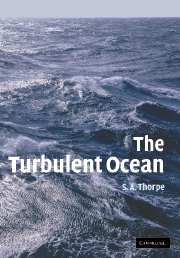Book contents
- Frontmatter
- Contents
- Preface
- Structure and résumé
- Acknowledgements
- 1 Heat, buoyancy, instability and turbulence
- 2 Neutral stability: internal waves
- 3 Instability and transition to turbulence in stratified shear flows
- 4 Convective instabilities
- 5 Instability and breaking of internal waves in mid-water
- 6 The measurement of turbulence and mixing
- 7 Fine-structure, transient-structures, and turbulence in the pycnocline
- 8 The benthic boundary layer
- 9 The upper ocean boundary layer
- 10 Shallow seas
- 11 Boundary layers on beaches and submarine slopes
- 12 Topographically related turbulence
- 13 Large-scale waves, eddies and dispersion
- 14 Epilogue
- Appendices
- References
- Index of laboratory experiments
- Subject index
- Plate section
5 - Instability and breaking of internal waves in mid-water
Published online by Cambridge University Press: 05 June 2012
- Frontmatter
- Contents
- Preface
- Structure and résumé
- Acknowledgements
- 1 Heat, buoyancy, instability and turbulence
- 2 Neutral stability: internal waves
- 3 Instability and transition to turbulence in stratified shear flows
- 4 Convective instabilities
- 5 Instability and breaking of internal waves in mid-water
- 6 The measurement of turbulence and mixing
- 7 Fine-structure, transient-structures, and turbulence in the pycnocline
- 8 The benthic boundary layer
- 9 The upper ocean boundary layer
- 10 Shallow seas
- 11 Boundary layers on beaches and submarine slopes
- 12 Topographically related turbulence
- 13 Large-scale waves, eddies and dispersion
- 14 Epilogue
- Appendices
- References
- Index of laboratory experiments
- Subject index
- Plate section
Summary
Introduction
Like turbulence, there is no commonly accepted or robust definition of wave breaking, although noble attempts have been made to formulate one (for example, see McIntyre, 1992, 2000; Staquet and Sommeria, 2002). Breaking is a process by which, usually in times comparable to their characteristic period, waves lose energy and generate turbulent motions that, at least initially, are commonly of scale smaller than the wavelength of the breaking waves themselves. On longer time scales, breaking may also result in the generation of residual mean motions including, for example, circulatory motions. (Examples are the ‘rotors’ generated by surface gravity waves breaking in deep water described in Section 9.1 and shown in Fig. 9.2.) In the case of internal waves, breaking is accompanied by distortions of isopycnals, and leads to an irreversible diapycnal transfer of water properties such as heat and salinity, or ‘mixing’. Secondary waves, shorter than the breaking waves, are sometimes involved in the process of breaking: steep, short surface gravity waves may generate shorter capillary gravity waves that lead to the rupture of the water surface or the generation of turbulence (Section 9.2.1).
Breaking can be regarded as a short-lived transitional process leading from a relatively quiescent, quasi-periodic flow (but one that may already contain some residual turbulent motions, for example from earlier breakers) to a state of greater small-scale activity, although this active state may be transient, dissipating fairly rapidly, and localized in space. As defined above, breaking involves energy transfer to turbulence.
Information
- Type
- Chapter
- Information
- The Turbulent Ocean , pp. 144 - 171Publisher: Cambridge University PressPrint publication year: 2005
